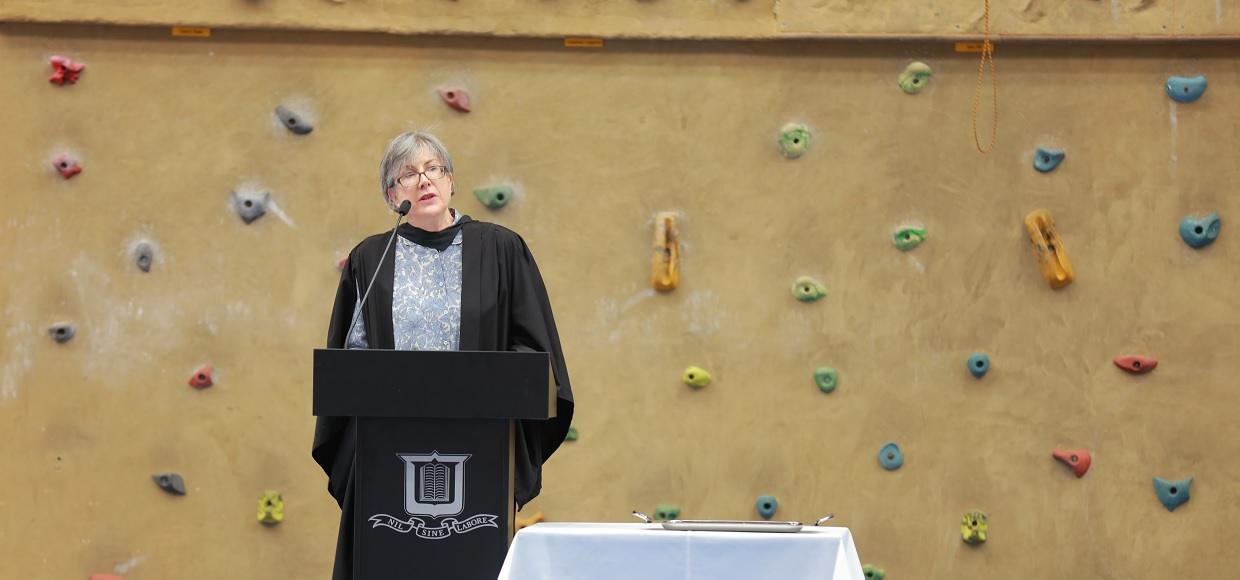
Head of History, Ms Julie Hennessey presenting the Australia Day Assembly Address
Good morning Principal, Ms Euler, President of the P&F Association, Dr Fiona Harden, colleagues and girls.
I would like to begin by acknowledging the Turrbal People, the Traditional Owners of the land on which we gather today. I would also like to pay my respects to Elders past, present and emerging.
Australia Day, Foundation Day, Day of Mourning, Invasion Day, Survival Day. These different names attributed to our national holiday on 26 January are a reminder that this day has a long history of celebration as well as contestation.
Australia Day, which commemorates the arrival of the First Fleet and the raising of the British flag at Sydney Cove in 1788, has its own history and the significance attached to it has changed over time.
The idea of an Australia Day was initially adopted by all states and territories 83 years ago in 1935, but it was only 24 years ago, in 1994, that all states and territories agreed to hold the Australia Day public holiday on 26 January instead of the nearest Monday.
For as long as it has existed, Australia Day has been the focus of protest. The first national protest was in 1938, the 150th anniversary of the arrival of the First Fleet. On that day, 100 Aboriginal people gathered in Australian Hall in Sydney and called for a ‘Day of Mourning and Protest’. At the 200th anniversary in 1988, tens of thousands of people, both Indigenous and non-Indigenous, protested and the name ‘Invasion Day’ gained prominence.
Thereafter, each year, Australia Day raises questions and issues that go to the heart of our national identity, history and values. The timing of Australia Day—an issue that has been quietly simmering for decades—has recently taken centre-stage in the current debate.
While the campaign-cum-movement to ‘Change the Date’ has quickly gained momentum, particularly in the past twelve months, it has faced opposition.
Local government led the charge to change the date in 2017. The City of Fremantle in Western Australia sought to celebrate Australia Day last year on an alternative date (28 January), but ultimately did not proceed due to a backlash from local businesses and the federal government. Then in August, city councils in Melbourne (Yarra and Darebin) announced that they would stop referring to 26 January as Australia Day, and would cease holding citizenship ceremonies on that day. In response, the federal government took away the right of these councils to hold citizenship ceremonies.
In November, radio station, Triple J, confirmed that it was moving the broadcast of ‘Hottest 100 countdown’ (billed as the ‘biggest music celebration of the year’) from Australia Day to 27 January, acknowledging ‘increasing debate’ about 26 January and its meaning for Indigenous Australians. There were calls from some listeners to boycott the station and the Government asked the ABC’s Board to reconsider the decision.
In terms of federal politics, the Greens, just a week ago (15 January 2018), launched a campaign to have the date of Australia Day changed—a campaign that is not supported by either the federal Liberal-National government or the Labor opposition.
As far as Indigenous Australians are concerned, the three leading Indigenous organisations—Reconciliation Australia, the National Congress of Australia’s First Peoples (the peak body representing Aboriginal and Torres Strait Islander people) and the Healing Foundation (the peak body representing survivors of the stolen generations)—are all pushing for a date change. However, a few prominent individual Aboriginal Australians, such as Warren Mundine and Jacinta Price, have spoken out against focusing on this issue. A key argument advanced is that it obscures the real problems facing some Aboriginal people—poor health, community dysfunction, unemployment, child neglect and poor school attendance.
While debate about changing the date of Australia Day has moved from the margins into the mainstream, it remains divisive and, at times, very heated.
Interestingly, a recent poll published on 17 January 2018 by the Australian Institute, a Canberra-based think-tank, suggests that Australians are ‘laid back about Australia Day’. The poll asked a nationally representative sample of about 1400 Australians about their knowledge of, and attitudes to, Australia Day. It found that while the vast majority of Australians (84 per cent) believe Australia Day is important, 56 per cent do not mind when Australia Day is held. The polling also showed that most Australians do not know what historical event Australia Day commemorates and most people are not aware that Australia Day was not always celebrated on 26 January (The Australian Institute, 2018).
This Australia Day then, provides an opportunity for us to learn about and reflect upon our history, as well as become informed participants in, or observers of, this important national conversation about the date.
There is no denying the historical significance of 26 January. It is a watershed moment—a turning point in Australian history—and should be understood and remembered. But the crucial question currently being debated is whether 26 January is the right date to celebrate Australia and all we love about this nation: the land and our lifestyle; our freedoms, democracy, sense of a fair go, and ‘mateship’; and our diversity, prosperity and peace?
So, what about the date? The arrival of the First Fleet at Sydney Cove on 26 January 1788 was part of an extraordinary venture to establish a British penal settlement in Australia. Tim Flannery (1996) comments that it must have seemed every bit as extraordinary as sending a man to the moon. At the time, it was the single biggest overseas migration the world had ever seen (Hill, 2008). About 1500 people (approximately 780 of them convicts) sailed in 11 ships—the largest was less than 40 metres long—on a voyage that would take eight months. They also carried two years’ supply of food and the equipment needed to build a new settlement once they reached their destination. Australia at the time was the last of the habitable continents to be colonised by Europeans. It lay half way around the world from Britain—almost 21 000 kilometres. Its flora, fauna, geography and indigenous people were almost entirely unknown.
The voyage was remarkably successful. The fleet arrived first at Botany Bay and later Sydney Cove without the loss of a single ship, and there were fewer deaths than on most of the following transports that would bring convicts to Australia over the next 50 years. Additionally, 14 pregnant woman gave birth during the voyage.
Imagine what it must have looked like to the local Aboriginal people when the tall ships comprising the First Fleet sailed into the harbour known as Warrang (now called Sydney Harbour). Aboriginal academic, Professor Marcia Langton (2008), comments that the response must have been ‘an overwhelming feeling of suspense as they watched this strange apparition on the water’—first one, then another and another, until all 11 ships had found anchor. These ships were larger than anything Aboriginal people had ever seen and yet they drifted across water. Were these ghosts coming in giant canoes with wings?
Governor Phillip had received strict orders from King George III about how he and his compatriots were to treat the Aboriginal people upon settlement: ‘You are to endeavour by every possible means to open an intercourse with the natives, and to conciliate their affections, enjoining all our subjects to live in amity and kindness with them’. In short, Phillip was required to develop friendly relations with the Indigenous population. These instructions existed alongside orders to establish a viable settlement, an endeavour which could only be achieved by invading and occupying Aboriginal land. Words and deeds were not in alignment.
Most of human history in Australia is Aboriginal history, which we now know extends to at least 65 000 years, or about 2 600 generations. In contrast, non-Aboriginal Australians have resided in Australia for 230 years, or about nine generations. The Sydney Morning Herald (20 July 2017) quantified Aboriginal presence in Australia in these terms: ‘If Aboriginal culture were 24 hours old, white people have been in Australia five minutes’.
In these ‘five minutes’ Indigenous Australians lost most of their land, languages and culture. They were dispossessed, dislocated and mistreated. The 26 January date is an ongoing reminder of this loss and pain for Indigenous Australians. For them it is a day of mourning but also a day of protest and defiance—a survival day.
We cannot change history, and we should not feel the burden of guilt about our history. But we can shape the future by being active participants or informed observers in national debates such as this.
Former Liberal minister, Ian MacFarlane, who describes himself as a ‘conservative, Anglo-Celtic Australian’ stated in his Australia Day address last year that: ‘It’s not about pleasing people, it is about uniting people. It’s about healing a wound, drawing a line, [and] getting on with the really important issues facing our indigenous communities’ (MacFarlane, 2017).
If the date of Australia Day were to change, there is no clear answer as to what that date should be—that’s another conversation.
The point of Australia Day is to celebrate as a nation, and there is much to celebrate. Our robust democracy enables divergent views to be voiced and provides us with the means to peacefully resolve differences of opinion.
The current debate is not about the day, it is about the date. It is about reflecting upon the meaning and significance of this date, and whether it is the best date to celebrate what we value as a nation and how we see ourselves as a nation.
References
The Australia Institute. (2018, January 17). Australians laid back about Australia Day–poll. Retrieved from http://www.tai.org.au/content/australians-laid-back-about-australia-day-poll.
Flannery, T. (Ed.). (1996). 1788: Watkin Tench. Melbourne, Vic: The Text Publishing Company.
Hill, D. (2008). 1788: The Brutal Truth of the First Fleet. North Sydney, NSW: William Heinemann Australia.
Langton, M. (2008). They made a solitude and called it peace. In R. Perkins & M. Langton. (Eds). First Australians. Carlton, Vic: Miegunyah Press.
MacFarlane, I. (2017, January 26). Change the date of Australia Day–A conservative’s perspective. Parliament House, Melbourne: The Australian Unity Great Australia Day Breakfast. Retrieved from https://www.australianunity.com.au/about-us/australia-day.




